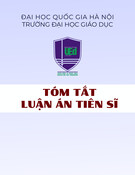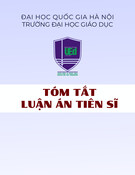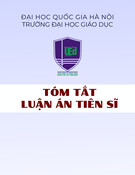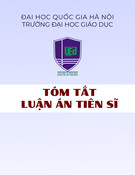
1
PRODUCTION
1. The urgency of the thesis
Oke (2015) argued that human resource management continues to play a central
role in enterprises. “Human resource management is being proposed to solve corporate
problems such as quality management, lean production, technology improvement and
business process change” (Lu et al., 2015).
In practice, according to the General Statistics Office (2018), as of December 31,
2018, the total number of operating enterprises in the country was 714,755, of which
the number of service enterprises had business results. sales of 390,765 enterprises,
accounting for 54.7% (Ministry of Planning and Investment, 2019). However,
according to the General Statistics Office (2017a), the service sector had the largest
proportion of enterprises but attracted only 4.9 million employees, accounting for
33.8%. Meanwhile, the manufacturing and manufacturing sector has only 164,189
enterprises, accounting for 23.9% but attracts the most number of employees with 9.3
million employees, accounting for 64.4%. Therefore, it is very necessary to study the
human resource management system in both manufacturing and service sectors in
Vietnam because these two fields account for 97.2% of the total number of employees.
more than 14.2 million people.
In theory, Fu et al. (2015) concluded that a high performance human resource
management system is the key determinant of innovation. And innovation is an
important factor affecting firm performance (Atalay et al., 2013; Nguyen, 2020).
However, practices in the high performance human resource management system are
still inconsistent (Delety and Dorty, 1996; Armstrong, 2008; Zhang and Moris, 2014).
Many studies in developed countries such as Armstrong (2008) in USA, Chen and
Huang (2009) in Taiwan, Chow et al (2012) in Singapore, Fu et al (2015) in Ireland,
Lu et al. (2015) in China showed that a high performance human resource
management system lacked job security. But unlike developed countries, currently,
most Vietnamese enterprises often sign indefinite contracts (36.1%) (Ministry of
Labor, Invalids and Social Affairs, 2017) with employees, who have good skills and
expertise to help them feel secure to work in the enterprises. An indefinite term
contract allows employees to work as long as they want at the company. At the same
time, when signing an indefinite term contract, the employee will not be fired without
a serious violation of discipline.
2
In addition, in the context of the Vietnamese economy, “most workers still want
to work in large firms (Webster, 1999) and in the state sector (Marlow and Patton,
2002) for entrepreneurs. Private or small enterprises do not have job guarantees” (cited
by Nguyen and Bryant, 2004). Research by Le and Truong (2005) in Vietnam also
showed that job security is an important factor because if employees receive a long-
term commitment to work, they will try to make efforts as well as make full use of the
ability to advance in the enterprise, contribute to improving the operational
performance. Besides securing jobs for employees (Le and Truong, 2005), research by
Zhu (2002) in Vietnam also concluded that enterprises also need to focus on securing
jobs for good managers. employees have the skills to keep them in the business for the
long term. In addition to having a positive impact on performance (Nguyen and
Bryant, 2004; Le and Truong, 2005), by ensuring jobs for their workers, enterprises in
Vietnam can maintain and enhance their performance. the amount of human resources
towards important innovation results, contributing to improving competitiveness in
domestic and foreign markets (Ngo et al., 2017). At the same time, securing work also
helps strengthen the relationship between administrators and employees, thereby
enhancing innovation and performance in Vietnamese enterprises (Nguyen, 2020).
Besides, according to the high uncertainty avoidance aspect of Hofstede (1980), the
study of Nguyen and Le (2007) showed that Vietnamese people like to be guaranteed
at work. Therefore, it can be concluded that job security is a key element of a high
performance human resource management system that positively affects innovation
and firm performance. Therefore, in this study, the author has added and developed a
scale for the factor "job security" to suit the research context in Vietnam.
Besides, at present, in Vietnam and around the world, there are very few studies
on the impact of the high performance human resource management system on
innovation, especially innovative behavior in enterprises. Therefore, stemming from
the above theoretical and practical needs, the author has chosen the topic: “The
relationship between the high performance human resource management system,
innovation and firm performance of enterprises in Vietnam” to carry out research topic
Doctoral thesis.
2. Research objective
2.1. Overall objective
The thesis is carried out with the aim of building and testing the model on the
relationship between high-performing human resource management system, innovation and
firm performance.

3
2.2. Detail objective
(1) Consider the impact of a high performance human resource management
system on innovation and corporate performance.
(2) Consider the mediating role of innovation in the relationship between a high
performance human resource management system and performance.
(3) Proposing management implications to enhance operational results through
improving a high performance human resource management system as well as
enhancing innovation in the enterprise.
3. Research questions
Question 1: How does a high performance human resource management system
affect on firm performance?
Question 2: How does a high performance human resource management system
affect on innovation?
Question 3: How does innovation affect on firm performance?
Question 4: Consider the difference in the relationship between a high performance
human resource management system and the firm performance according to the
company's characteristics?
4.Object and scope of the research
4.1. Research object
The thesis's research object is the impact of the high performance human
resource management system on innovation and operational performance in
manufacturing and service enterprises in Vietnam. Accordingly, high performance
human resource management suystem, innovation and firm peroformance will be
studied on the organizational level and not focused on the individual level. At the same
time, for innovation in enterprises, the thesis focuses on research on the process of
innovative behavior in enterprises. And innovation will be judged by managers.
4.2. Research scope of the subject
In term of subject space, the thesis focuses on manufacturing and service
enterprises in the North, Central and South of Vietnam.
In term of subject duration, the thesis used primary data base on the survey of
senior and middle-level executives in manufacturing and service enterprises in
Vietnam from 2017 to present in order to test the hypotheses on the sample size of 312
enterprises in 22 provinces/cities of Vietnam.
In term of research content, the main content of the thesis focuses on building
and testing, estimating models of the relationship between high-performance human
resource management system, innovation and firm performance. Besides, the thesis
4
also analyzes and evaluates the firm performance according to the characteristics of
the enterprise such as size (calculated by the number of employees), number of years
of operation and business sector.
4.3. Research methodology
The thesis has used a combination of qualitative research methods and
quantitative research. Qualitative research methods are used to supplement and
develop a scale for the "job security" factor of the high performance human resource
management system. As for the quantitative research method, the thesis uses popular
data processing tools: Descriptive statistical analysis, scale reliability analysis
(Cronbach's Alpha), exploring factor analysis (EFA), linear regression analysis by
ordinary least squares method (OLS) to test research hypotheses.
5. New contributions of the research
In theory, the thesis has added a job guarantee factor in the highly effective human
resource management system. The thesis’s result shows that innovation plays an
intermediate role in the relationship between high performance human resource
management system and firm performance.
In practice, through the testing of the research model between the high
performance human resource management system, innovation and firm performance,
the thesis has proposed solutions to help manufacturing and services enterprises in
Vietnam focus on improving a high performance human resource management system
as well as elements of innovation to increase firm performance.
6. Structure of doctoral thesis
In addition of introduction and conclusion, the thesis has 4 chapters:
Chapter 1: Literature review and background theories
Chapter 2: Research methodology
Chapter 3: Research results
Chapter 4: Conclusion and recommendations

5
CHAPTER 1. BACKGROUND THEORIES, LITERATURE REVIEW AND
RESEARCH MODEL
1.1. Definitions
1.1.1. High performance human resource management system
High-performance human resource management system is a collection of human
resource management practices, by improving the skills of workers, creating
opportunities for them to participate in the decision-making process, and promoting
workers' discretionary efforts to provide a firm competitive advantage reflected in
better financial results (Huselid, 1995; Way, 2000; Appelbaum et al., 2002). Research
by Delety and Dory (1996) suggest that high-quality human resource management
systems include activities: training, development, employee participation, performance
evaluation, profit sharing and job analysis.
1.1.2. Innovation
Carlino (2001) argued that innovation depends on changing the ideas of
employees in enterprises. At the same time, research by Kanter (1986) confirms that
the process of awareness and creation of new ideas is the beginning stage of
innovation. Therefore, many studies have suggested that all innovation activities in
enterprises originate from behavioral innovation in enterprises (Janssen, 2000;
Lumpkin and Dess, 1996; Lu et al., 2015). For example, Janssen (2000) gave the
definition of innovation work behavior as “creating, introducing and intentionally
applying new ideas in work at businesses. businesses to benefit businesses ”(cited by
Fu et al., 2014; Omri, 2015). Lu et al. (2015) based on research by Scott and Bruce
(1994) suggest that innovation consists of three manifestations: forming new ideas,
promoting new ideas and applying new ideas.
1.1.3. Firm performance
Medella (2005) defines firm performance that reflects the ability and efficiency
of an enterprise to use resources such as people, finance and facilities to achieve goals
of the business. Lee (2008) defines performance as the outcome of a business as
measured by financial or non-financial indicators. Murphy et al. (1996) think that the
performance of firms is a multidimensional concept.
Dawes's (1999) study on the relationship of market orientation to subjective
performance and objective performance suggests that subjective scales results are
consistent with objective scales. At the same time, Tan and Litschert (1994) also
conclude that in many studies, the use of subjective scales gives good results. Based on
the research of Danaley and Huselid (1996), Zhang and Li (2009) and Wang and
6
Wang (2012), firm performance includes: operationnal perfomance and market
performance.
1.2. Relationships
1.2.1. High performance human resource management system and firm
performance
At present, many studies in Vietnam and the world have shown that human
resource management systems have a positive impact on business performance
(Nguyen and Bryant, 2004; Datta et al, 2005; Le and Truong, 2005; Tsai, 2006; Chand
and Katou, 2007; Sun et al., 2007; Armstrong et al., 2008; Bonias et al., 2010; Chow et
al, 2012; Zhang and Morris, 2014; Riaz, 2015).
1.2.2. High performance human resource management system and innovation
Many studies have shown that high-quality human resource management systems
positively impact business innovation in different contexts (Fu et al. , 2014). Most of
the studies on the impact of high-quality human resource management systems on
corporate performance have shown that innovation has a positive impact on the
performance of businesses (Beugelsdijk, 2008; Chen and Huang, 2009, Tan and
Nasurdin, 2011, Wei and et al, 2011; Prieto and Pérez-Santana, 2014; Fu et al, 2014;
Dhar, 2015; Do and Shipton, 2019).
1.2.3. Innovation and firm performance
Many studies have used linear regression analysis using the ordinary least square
method (OLS) (Amores-Salvadó et al., 2014; Nham et al., 2016; Nguyen et al., 2019)
or a structural equation model (SEM) (Wang and Wang, 2012; Lin, 2013; Omri, 2015;
Lu et al., 2015; Soto - Acosta et al., 2015) to assess the impact of innovation on
results. operation of businesses. Although these studies use different research methods,
they have come to the conclusion that innovation activities have a positive impact on
business performance.
1.2.4 . The mediating role of innovation
Based on an overview of the works in the world as well as the research of Baron
and Kenny (1986) on intermediary variables, it can be seen that innovation plays an
intermediary role in the relationship between the human resource management system.
high business results and operational performance. Because a highly effective human
resource management system with training and motivational activities will enhance
enterprise innovation activities by helping workers form new ideas, like promoting and
applying new ideas at work. At the same time, when businesses get new ideas and
apply these ideas in their work to improve products, services and processes, they will
increase operational performance.

7
1.3. Research gaps
Firstly, there are very few previous studies in Vietnam and the world that
mention the mediating role of behavioral innovation in the relationship between high-
performance human resource management systems and performance.
Secondly, previous studies still have many debates about the practices of a high
performance human resource management system. Therefore, based on the research
review and interviews with enterprises in Vietnam, the author has added a job
guarantee factor to the highly effective human resource management system.
Thirdly, previous studies on the relationship between high performance human
resource management systems, innovation and firm performance have left the impact
of control variables such as size (in terms of number of employees), the number of
years of operation and the business sector to the enterprise's performance. Therefore,
in the thesis, author has used the characteristics of the enterprise such as size
(calculated by the number of employees), the number of years of operation and the
business sector as control variables in the research model.
1.4. Background theories
1.4.1. Resource-based view
Most of the studies on the relationship between high-performance human
resource management systems and firm performance have been rooted in RBV by
Wernerfelt (1984) and Barney (1991) (Datta et al, 2005; Comb et al., 2006; Chand and
katou, 2007; Katou, 2008; Chadwick, 2010; Kroon et al, 2012; Jeong and Choi, 2015;
Rothenberg et al, 2015; Özçelik et al., 2016). The theory based on the resources of
Wernerfelt (1984) and Barney (1991) suggests that enterprises can only create a
competitive advantage when their resources ensure 4 factors: (1) Valuable, (2) rare, (3)
in-imitable and (4) non-substituable.
Source: Barney (1991)
Figure 1.1. Theoretical framework for resource-based governance
Resources
- Value
- Rare
- Imperfect Imitability
- Non-substitutability
Compettitive
Advantage
8
Human resource management systems are the most sensible competencies to
utilize the development of corporate human resources and use them to create core
competencies (Wright et al., 2001). In addition, if a business can improve its human
capital, it will help create a sustainable competitive advantage that competitors can
hardly copy or copy (Rothenberg et al., 2015). ; Özçelik et al., 2016). In addition,
based on resource theory (RBV), a high performance human resource management
system is a set of human resource activities that, by enhancing employee skills, create
participation in decision-making, and promoting employee self-efforts through forms
of motivation, can deliver a solid competitive advantage reflected in good financial
performance. (Huselid, 1995; Appelbaum et al., 2000; Way, 2002), thereby helping
businesses succeed (Richard et al, 2013).
1.4.2. Theory of economy development
Atalay et al. (2013), Lu et al. (2015), Nham et al. (2016) used the theory of
economic development of economists and scientists. German politics Schumpeter
(1934) to illustrate the relationship between innovation and firm performance.
Schumpeter (1934) argues that innovation is innovation. Innovation is the
physical or mental outcome of cognitive or behavioral activity through the use of all
resources and conditions by individuals to create new, intentional products, services
and technologies. meaning and value according to a certain purpose or task. At the
same time, the process of awareness and creating new ideas for employees is the
beginning stage of innovation in enterprises (Kanter, 1986). It can be said that
innovative forms of organization, new ideas and management methods to create new
products and services, new working methods and new technologies belong to
innovation.
Thereby, we can see that the formation and application of new ideas will help
businesses create new products and services. Schumpeter (1934) argues that product
innovation first introduced to the market will face direct but limited competition and
therefore businesses can receive relatively high profits. However, over time, this profit
may be reduced by imitation and competition in the market. But if businesses continue
to innovate and introduce new products to the market, they can achieve high profits in
a sustainable time (Sharma and Lacey, 2004). Like many other scholars, Varis and
Littunen (2010) also argue that the ultimate reason for businesses to engage in
innovation activities is to improve the performance of businesses and to succeed.

9
1.5. Research model and hypotheses
1.5.1. Research model
Based on literature review and background theories, the model is:
Figure 1.2. Research models
Source: According to the survey and analysis of the author
-
Independent variables: High performance human resource management system
includes: Training, employee participation, job analysis, performance evaluation,
employee development, profit sharing.
-
Dependent variables: Firm performance: Market and operational performance.
- Mediate variables: Innovation: Production of innovation, promotion of
innovation, và implementation of innovation.
- Control variables: Size (in terms of employee), years of operation, business
sectors.
HRM
Innovation Firm performance
Performance
evaluation
Training
Employee
participation Production of
innovation
Job analysis
Promotion of
innovation
Implementation
of innovation
Operational
performance
Market
performance
Employee
development
Profit sharing
Control variables
Job security
10
Table 1.1. Research hypotheses
H1 High performance human resource management positively impacts on firm
performance
H2 High performance human resource management positively impacts on
innovation
H3 Innovation positively impacts on firm performance
H4 Innovation plays an intermediary role in the relationship between high
performance human resource management system and firm performance


























